Leicester Castle
Leicester Castle is in the city of the same name in the English county of Leicestershire. The complex is situated in the west of Leicester City Centre, between Saint Nicholas Circle to the north and De Montfort University to the south. A large motte and the Great Hall are the two substantial remains of what was once a large defensive structure. The hall is now encased in a Queen Anne style frontage. The Castle and the Magazine Gateway is a scheduled monument.[1]
| Leicester Castle | |
|---|---|
| Leicestershire | |
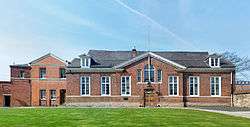 The Great Hall | |
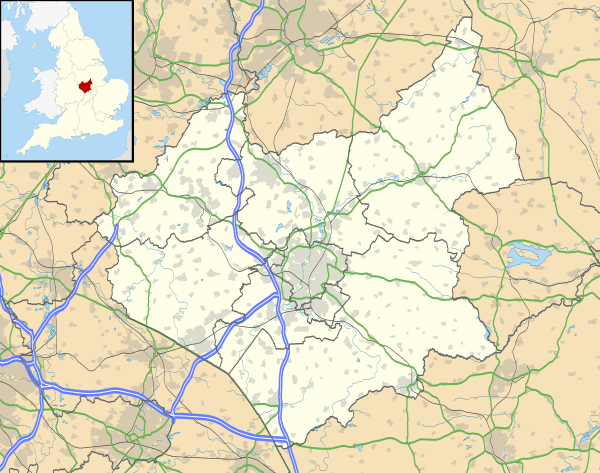 Leicester Castle Shown within Leicestershire | |
| Coordinates | 52°37′56.4″N 1°8′28.3″W |
| Type | Norman |
| Site information | |
| Open to the public | everyday |
| Site history | |
| Built | 11th century |
| Built by | William the Conqueror |
| In use | Law court |
| Official name | Leicester Castle and the Magazine Gateway |
| Designated | 26 June 1924 |
| Reference no. | 1012147 |
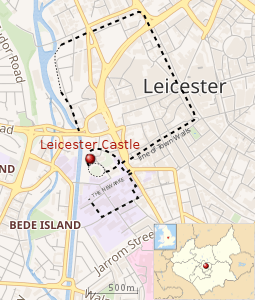 |
| Map of central Leicester. The dotted line shows the line of the medieval town walls. |
History
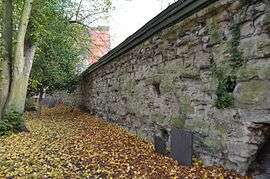
.jpg)
Leicester Castle was part of the medieval town defences, built over the Roman town walls.[2] The castle was probably built around 1070 (soon after the Norman Conquest in 1066)[3] under the governorship of Hugh de Grandmesnil. The remains now consist of a mound, along with ruins. Originally the mound was 40 ft (12.2 m) high. Kings sometimes stayed at the castle (Edward I in 1300, and Edward II in 1310 and 1311), and John of Gaunt and his second wife Constance of Castile both died here in 1399 and 1394 respectively.[4][5] Henry of Grosmont, 1st Duke of Lancaster, one of the leading captains in the early phases of the Hundred Years' War died at the castle on 23 March 1361.[6]
It became an official royal residence during the reigns of Henry IV, Henry V, Henry VI and Edward IV, but by the middle of the 15th century, it was no longer considered suitable[7] and was used mainly as a courthouse; with sessions being held in the Great Hall.[8] Apart from being used for Assize Courts, the Great Hall was also used for sessions of the Parliament of England most notably the Parliament of Bats in 1426, when the conditions in London were not suitable.[9]
A section of the castle wall, adjacent to the Turret Gateway, has gun loops (holes) that were poked through the medieval wall to use as firing ports by the city's residents when Parliamentarian Leicester was besieged, captured, and ransacked, during the English Civil War by the main Royalist Field army under Charles I and Prince Rupert on 31 May 1645.[10] The third storey of the Turret Gateway (erroneously known as 'Prince Rupert's gateway') was destroyed in an election riot in 1832.[11]
In the 1880s, J. M. Barrie visited the assize courts regularly and spent many hours inside as reporter for the Nottingham Journal when the hall was being used as a court house.[12]
See also
References
- Historic England. "Leicester Castle and the Magazine Gateway (1012147)". National Heritage List for England. Retrieved 8 September 2019.
- Creighton, O.H. (2002). Castles and landscapes : power, community and fortification in Medieval England (Pbk. ed.). London: Equinox. p. 143. ISBN 978-1-904768-67-8.
- "A History of Leicester Castle: The First Castle". Leicester City Council. 2013. Archived from the original on 2 July 2013. Retrieved 4 December 2013.
- Leland's Itenerary Vol.1 Page 17 The Collegiate Church Newarke Constance daughter of Peter King of Castile, and wife of John of Gaunt, lieth before that High Altar in a tomb of marble with an image [Brass] (Like A Queen) on it
- Charles James Billson, Mediaeval Leicester (Leicester, 1920)
- Fowler, Kenneth (1961). Henry of Grosmont, First Duke of Lancaster, 1310–1361 (PDF) (Thesis). Leeds: University of Leeds. p. 217-218.
- James Thompson (1849). The history of Leicester. Index. J.S. Crossley. pp. 456–.
- Simmons, Jack (1974). Leicester Past and Present: Vol. I. ; Ancient Borough to 1860. London: Eyre Methuen.
- "The Parliament of Bats – 1426". Semper-eadem.tripod.com. Retrieved 2012-06-24.
- "The Naseby Campaign". British Civil War Project. Retrieved 8 September 2019.
- "Turret Gateway: Description of the Ancient Monument". Leicester City Council. 2013. Archived from the original on 22 February 2011. Retrieved 4 December 2013.
- "From royal residence to business school - the fascinating history of Leicester Castle". De Montfort University. 6 May 2016. Retrieved 8 September 2019.
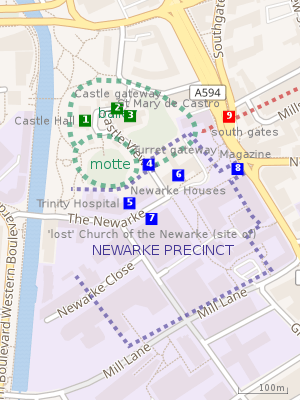 |
| Leicester Castle and The Newarke precinct, showing the Motte and bailey (green), boundary walls of The Newarke (blue), and the southern side of the town wall (red). The historic sites include:- 1 2 3 4 5 6 7 8 9 |
Further reading
- Fox, Levi (1941–42). "Leicester Castle" (PDF). Transactions of the Leicestershire Archaeological and Historical Society. 22: 127–170.
External links
| Wikimedia Commons has media related to Leicester Castle. |
